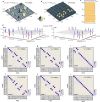A programmable qudit-based quantum processor
- PMID: 35246519
- PMCID: PMC8897515
- DOI: 10.1038/s41467-022-28767-x
A programmable qudit-based quantum processor
Abstract
Controlling and programming quantum devices to process quantum information by the unit of quantum dit, i.e., qudit, provides the possibilities for noise-resilient quantum communications, delicate quantum molecular simulations, and efficient quantum computations, showing great potential to enhance the capabilities of qubit-based quantum technologies. Here, we report a programmable qudit-based quantum processor in silicon-photonic integrated circuits and demonstrate its enhancement of quantum computational parallelism. The processor monolithically integrates all the key functionalities and capabilities of initialisation, manipulation, and measurement of the two quantum quart (ququart) states and multi-value quantum-controlled logic gates with high-level fidelities. By reprogramming the configuration of the processor, we implemented the most basic quantum Fourier transform algorithms, all in quaternary, to benchmark the enhancement of quantum parallelism using qudits, which include generalised Deutsch-Jozsa and Bernstein-Vazirani algorithms, quaternary phase estimation and fast factorization algorithms. The monolithic integration and high programmability have allowed the implementations of more than one million high-fidelity preparations, operations and projections of qudit states in the processor. Our work shows an integrated photonic quantum technology for qudit-based quantum computing with enhanced capacity, accuracy, and efficiency, which could lead to the acceleration of building a large-scale quantum computer.
© 2022. The Author(s).
Conflict of interest statement
The authors declare no competing interests.
Figures





References
-
- Giustina M, et al. Significant-loophole-free test of bell’s theorem with entangled photons. Phys. Rev. Lett. 2015;115:250401. - PubMed
-
- Liao SK, et al. Satellite-to-ground quantum key distribution. Nature. 2017;549:43–47. - PubMed
-
- Liao SK, et al. Satellite-relayed intercontinental quantum network. Phys. Rev. Lett. 2018;120:030501. - PubMed
-
- Arute F, et al. Quantum supremacy using a programmable superconducting processor. Nature. 2019;574:505–510. - PubMed
Grants and funding
LinkOut - more resources
Full Text Sources

